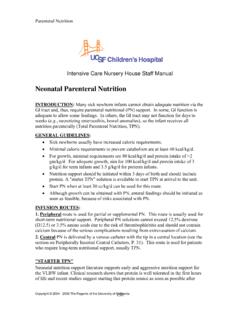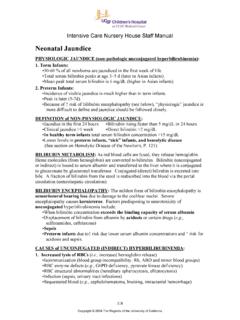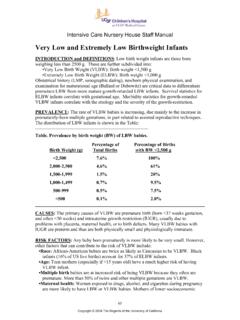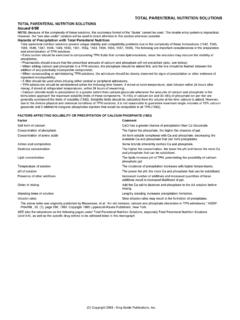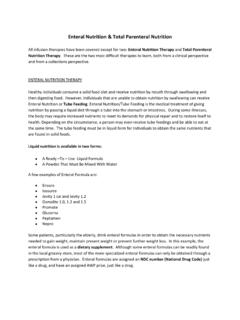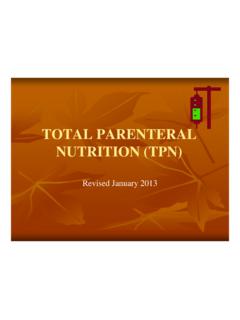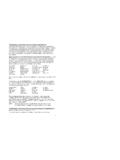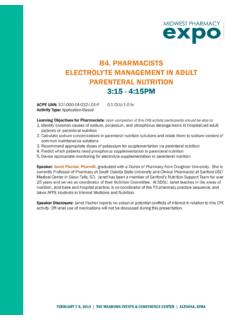Transcription of Neonatal Parenteral Nutrition
1 Parenteral Nutrition Copyright 2004 - 2006 The Regents of the University of California 136 Intensive Care Nursery House Staff Manual Neonatal Parenteral Nutrition INTRODUCTION: Many sick newborn infants cannot obtain adequate Nutrition via the GI tract and, thus, require Parenteral nutritional (PN) support. In some, GI function is adequate to allow some feedings. In others, the GI tract may not function for days to weeks ( , necrotizing enterocolitis, bowel anomalies), so the infant receives all Nutrition parenterally (Total Parenteral Nutrition , TPN). GENERAL GUIDELINES: Sick newborns usually have increased caloric requirements. Minimal caloric requirements to prevent catabolism are at least 40 kcal/kg/d. For growth, minimal requirements are 80 kcal/kg/d and protein intake of >2 gm/kg/d. For adequate growth, aim for 100 kcal/kg/d and protein intake of 3 g/kg/d for term infants and g/kg/d for preterm infants. Nutrition support should be initiated within 3 days of birth and should include protein.
2 A "starter TPN" solution is available to start TPN at arrival to the unit. Start PN when at least 30 cc/kg/d can be used for this route. Although growth can be obtained with PN, enteral feedings should be initiated as soon as feasible, because of risks associated with PN. INFUSION ROUTES: 1. Peripheral route is used for partial or supplemental PN. This route is usually used for short-term nutritional support. Peripheral PN solutions cannot exceed dextrose ( ) or amino acids due to the risk of thrombophlebitis and should not contain calcium because of the serious complications resulting from extravasation of calcium. 2. Central PN is delivered by a venous catheter with the tip in a central location (see the section on Peripherally Inserted Central Catheters, P. 31). This route is used for patients who require long-term nutritional support, usually TPN. "STARTER TPN" Neonatal Nutrition support literature supports early and aggressive Nutrition support for the VLBW infant.
3 Clinical research shows that protein is well tolerated in the first hours of life and recent studies suggest starting that protein source as soon as possible after Parenteral Nutrition Copyright 2004 - 2006 The Regents of the University of California 137birth with higher initial amounts is well tolerated. "Starter TPN" is now available on the unit to decrease the amount of time the infant is without a protein source. 1. Target infants are <1200 grams or <30 weeks or those expected to require parental support based on diagnosis (eg. CDH, TEF, gastroschisis). The "starter" TPN may also be used if the patient specific prescribed TPN needs to be held for access issues (loss of PICC) or if the patient is made NPO and TPN needs to be started. 2. 150 ml bags of , no electrolytes are stocked in the ICN East refrigerator. 3. The admitting MD/NNP writes the admit orders to initiate "starter" TPN as one of the IVF at 60-80 ml/kg/d. The starter TPN must be specified as at __ml/hour.
4 4. Maximum "starter" TPN amount is 100 ml/kg/day. Additional IVF will be ordered separately. 5. For fluid restriction, the "starter" TPN can run at a lower rate but the protein intake will be lower than target. 6. The admitting MD/NNP will also write the TPN order for the next bag, advancing as per ICN guidelines. An order to discontinue the "starter TPN" solution once the new TPN arrives will be written as well. COMPONENTS OF Parenteral Nutrition include: 1. Protein is administered as a solution of amino acids, Premasol , a preparation designed for pediatric patients. All infants in the ICN should receive Premasol . Start amino acids at 2-3 g/kg/d, as much as possible depending on fluid allowance and access. The traditional step-wise advance of protein has not been found to be necessary and may be negatively affecting the infants' nutritional status. Advance by gm/kg/d to goal as needed. Maximum is 3 g/kg/d in term infants and g/kg/d in preterm infants. Include protein in you calorie count.
5 Protein yields 4 kcal/g. Potential complications/risk include: Acidosis Elevated BUN Hyperammonemia Cholestasis with prolonged administration 2. Carbohydrate is administered as dextrose monohydrate. Start with 4-6 mg/kg/min or Alternatively, calculate the glucose infusion rate that the infant is already receiving and advance from there. Parenteral Nutrition Copyright 2004 - 2006 The Regents of the University of California 138 Very preterm infants may not tolerate that much dextrose and may even need insulin as an infusion to achieve adequate caloric intake without hyperglycemia. Advance by 1-3 mg/kg/min daily to a maximum of 12 mg/kg/min (up to 15 mg/kg/min in selected cases). Dextrose yields kcal/g. Consult reverse side of TPN order sheet for maximal allowable dextrose/amino acid concentrations. Potential complications/risks include: o Hyperglycemia or hypoglycemia o Glycosuria and potential osmotic diuresis o Cholestasis and/or hepatic steatosis with high caloric intake usually from long-term high concentration infusion.
6 3. Fat: Intravenous lipid emulsions are essential components of TPN. They provide essential fatty acids and are a concentrated energy source critical for growth and development of infants not receiving enteral feedings. There are potential safety concerns regarding administration of lipid emulsions to very low birth weight infants and infants with hyperbilirubinemia, pulmonary hypertension and serious pulmonary disease. To maximize benefits of lipids and minimize their adverse effects, use the following guidelines: (a) provide sufficient lipids to prevent essential fatty acid deficiency; (b) monitor for evidence of lipid intolerance; (c) adjust lipid dose based on clinical status. A lipid intake of g/kg/d is required to prevent essential fatty acid deficiency. Include lipid emulsion in calculations of total fluid intake. Lipids yield 10 kcal/g. IV lipid preparations are available as a 20% soybean emulsion that yields 2 kcal/mL. See Table below for starting and advancing lipids.
7 Deliver IV lipids over 24 hours. Do not allow lipids to exceed 60% of total caloric intake. Potential complications/risks include: o Hyperlipidemia o Potential risk of kernicterus at low levels of unconjugated bilirubin because of displacement of bilirubin from albumin binding sites by free fatty acids. As a general rule, do not advance lipids beyond g/kg/d until bilirubin is below threshold for phototherapy o Potential increased risk or exacerbation of chronic lung disease o Potential exacerbation of Persistent Pulmonary Hypertension (PPHN) o Lipid overload syndrome with coagulopathy and liver failure Table 1. Guidelines for starting and increasing IV lipid emulsions by clinical status. Gestation Weight/Diagnosis Initiate Advance by Goal is Parenteral Nutrition Copyright 2004 - 2006 The Regents of the University of California 139( g/kg/d) g/kg/d 3 g/kg/d by <1,500 g, stable DOL 3 DOL 7 DOL 11 1,500 g, stable DOL 3 DOL 4 DOL 9 Preterm Very unstable ( , severe RDS, bilirubin) DOL 3 When status improves No pulm.
8 Disease DOL 3 DOL 4 DOL 9 Term Severe pulm. disease, PPHN, MAS Consider DOL 7 When status improves (DOL, day of life; pulm., pulmonary; PPHN, persistent pulmonary hypertension of newborn; MAS meconium aspiration syndrome) 4. Electrolyte requirements are stated on the Parenteral Nutrition order form and must be adjusted according to serum values and clinical condition. (See section of Fluids and Electrolytes, p. 56) Initial PN solutions may be started without added electrolytes. Add electrolytes gradually as the patient becomes more stable. Acetate is metabolized to HCO3- and is added to adjust acid-base status. It can be ordered maximize, minimize, or balance with chloride depending upon an infant's acid-base status. 5. Minerals: Preterm infants and term infants receiving long-term Parenteral Nutrition are at increased risk for bone demineralization and fractures. Calcium (Ca) and phosphorus (P) delivery should be maximized for all infants receiving PN. Calcium is only allowed if the TPN if the line is central.
9 If only a peripheral line is available, add phosphorus to the TPN and give Ca gluconate separately. Only 1 mineral may be added if the solution also contains sodium or potassium. The maximum P=Total Cation X Mark Premasol box. Determine current dose of calcium prescribed in mEq of elemental calcium/kg. (approximately 1 mEq Ca=2mg Calcium gluconate) If the current calcium gluconate dose significantly exceeds the goal amount, start calcium in the TPN at goal (as solubility allows) and give additional Ca gluconate boluses as needed monitoring ionized calcium. Wean off the boluses as tolerated. See table below for advancement. Try to keep a Ca (mEq) to P (mmol) ratio of 2:1. Check Premasol solubility table on back of TPN form. Advance as long as Cai< To treat a high Cai, increase the P. Be sure the patient isn t receiving too much calcium ( in the TPN and concurrent Ca gluconate boluses) Follow ionized calcium and weekly pediatric TPN panels. Do not start magnesium until the serum level is < mg/dL.
10 Table 2. Parenteral Calcium and Phosphorus Doses: Calcium (mEq/kg) Phosphorus (mmol/kg) Initiate 2 mEq/kg 1 mmol/kg Advance every 1-2 days mEq/kg mmol/kg Goal 3 mEq/kg (preterm) 2 mEq/kg (term) mmol/kg (preterm) mmol/kg (term) Parenteral Nutrition Copyright 2004 - 2006 The Regents of the University of California 140 Table 3. Normal Serum Values: >1 week of age Ionized calcium (mmol/L) Total Calcium (mg/dL) Phosphorus (mg/dL) Magnesium (mg/dL) Preterm 8-11 6-8 Term 8-12 6. Other Additives include: Trace elements are recommended as mL/kg/d of trace element solution containing zinc, manganese, copper, and chromium.
